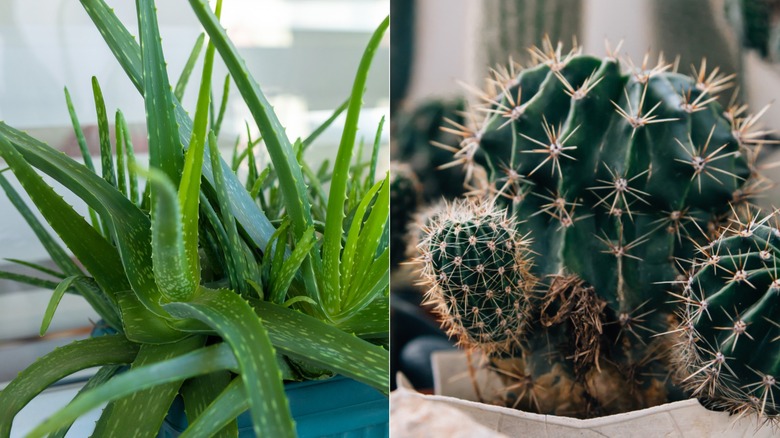Growing succulent plants together is a stellar way to maximize color, shape, and height in your planter or garden bed. However, not every variety can flourish in the same vicinity. Different sunlight, soil, temperature, and water requirements make certain succulents incompatible. Here, we have eight pairs of popular cacti and succulent species that you definitely shouldn’t house in the same planter or plant bed if you want a thriving garden.
Of course, you can still grow both species under your green thumb, but preferably, just not in the same flower pot. It is possible the growing needs of one plant can harm the other. When pairing succulents together, you want to look for varieties that share the same growing season, hardiness, and care. This way, they both can peak at the same time and flourish together for the optimal garden. There are several compatible succulent pairs, so don’t worry if you’ve already peppered your cactus with random greenery. But going forward, here are some pairs to avoid.
Aloe vera and cacti

While aloe vera and cacti plants have similar soil and water requirements, their sunlight needs differ. Aloe vera prefers indirect sunlight, even light shade. Too much sunlight can cause its leaves to burn. On the other hand, a cactus prefers direct sunlight. This special group of succulents has a unique form of photosynthesis in their stem instead of their leaves, allowing them to withstand harsher light. Instead, try pairing cacti with a full-sun-loving succulent, like the ghost plant (Graptopetalum paraguayense).
Sedum and echeveria
When it comes to sedum and echeveria, water is where they differ. Sedum needs thorough watering when it is first planted to get established in the soil. Then, it should be watered when the first 2 inches of its topsoil is dry. However, echeveria is sensitive to over-watering. It only needs a drink once all of its soil has dried. Subjecting this succulent to the watering needs of sedum may cause the echeveria to suffer root rot and bait mealybugs.
Ceropegia woodii and cacti
DimaBerlin & DAndreev/Shutterstock
Ceropegia woodii, better known as the string of hearts plant, may not grow well with cacti for the same reason aloe vera won’t — they have different sunlight needs. The succulent’s heart-shaped leaves can easily burn in the sun, so it is best kept in bright yet indirect light. However, your cacti prefer bounties of direct lighting. Plus, Ceropegia woodii seems to do better as a houseplant, while cacti can thrive outdoors, at least during the non-winter months.
Aeonium and sempervivum
Wirestock/Getty
Aeoniums like water more than the average succulent. It is safe to water your aeoniums when the first inch of topsoil is dry. However, the same method can water log sempervivums as they only need a refill when all their soil is dry. Sempervivums can also tolerate colder climates as low as 0 degrees Fahrenheit, while aeoniums need at least 65 degrees Fahrenheit for the best growing conditions. Sedum and agave are better companion plants for sempervivum species. And if you need a soil buddy for your aeoniums, try Crassula.
Lithops and othonna
SIM ONE & anidaaripin/Shutterstock
Lithops is a winter dormant succulent, and othonna is summer dormant, making these plants incompatible. While othonna is resting in the warmer season, you should avoid watering it. However, lithops will be in the middle of their growing season and need the hydration. Therefore, it won’t be possible to satisfy both their care needs while they are rooted in the same garden bed. But you can enjoy both these plants in their separate pots.
Gasteria and titanopsis
SukkaPhota & Tarda Santo/Shutterstock
For a beautiful garden bed or flower pot, you want succulents that have the same growing season — gasteria and titanopsisdo not. The former succulent is a summer dormant plant. During the peak of hot weather, its growth slows down, and its leaves may start to wither. On the other hand, titanopsis thrives throughout the summertime and goes dormant in the winter. The continued watering of one succulent while the other next to it is in a deep sleep can kill the dormant plant.
Crassula and kalanchoe
K.Jagielski & SE-photo/Shutterstock
Crassula and kalanchoe are another pair of succulents that may do better apart than together. As a houseplant, you have to place the kalanchoe in an area with no light for 14 hours to reset its bloom cycle. But the crassula needs indirect light all day or at least six hours of direct sunlight to flourish. However, besides that, their watering needs and soil needs are similar and should not interfere with either other’s growth.
Senecio and agave
DimaBerlin & Tom Windeknecht/Shutterstock
Senecio plants are known as tender or soft succulents. This type of greenery can not tolerate low temperatures and would not survive a frost. Hardy succulents like agave don’t mind the cold as much, and many varieties can withstand 20 degrees Fahrenheit and lower. These plants won’t endure the winter season the same, and you may have a wilting senecio next to a shining agave if you mistake them for companion plants. It is best to sew hardy succulents together and soft succulents with ones alike.


